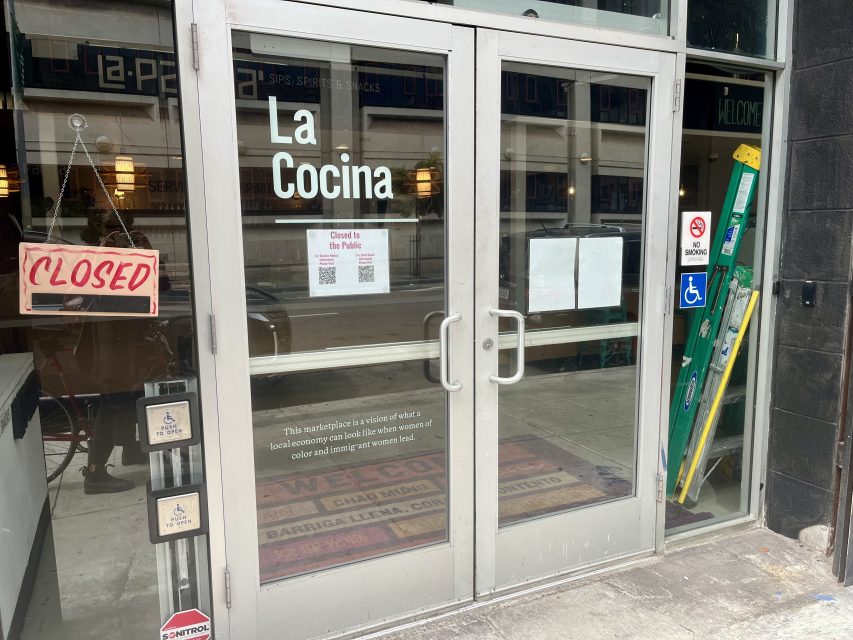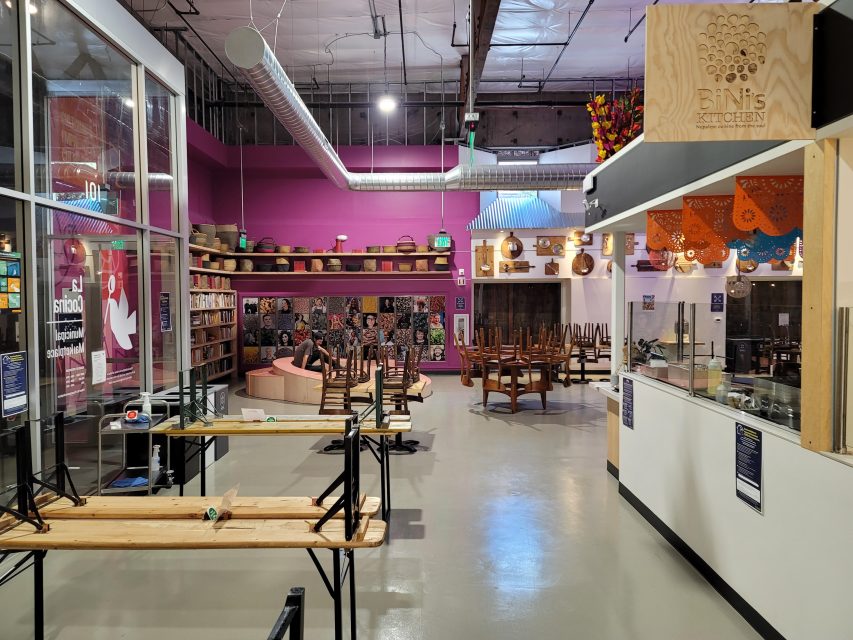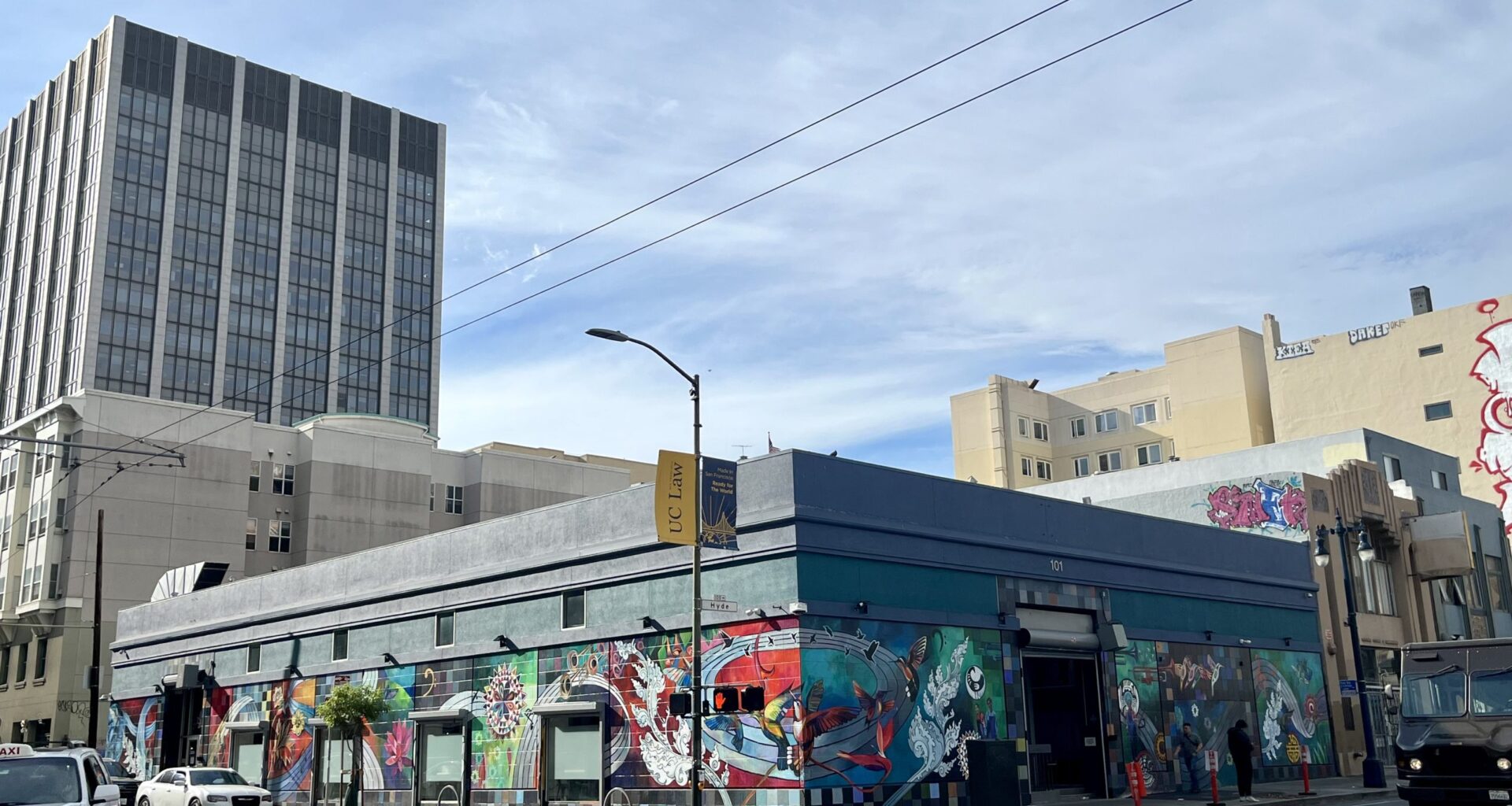The large gray building at the corner of Golden Gate Avenue and Hyde Street is covered in a colorful mural evoking music, nature, and the diversity of the Tenderloin. Upon a closer look, the blinds are drawn, and signs in the locked doorways read: “Closed to the Public.”
On a recent afternoon, a passerby looked up at the building and shook his head: “It’s a shame.”
San Francisco city departments, citing a difficult funding climate, have decided to again stall a planned 85-unit affordable housing project at 101 Hyde St. despite its location in the city’s poorest neighborhood. Instead, Mission Local has learned, the city will award a five-year extension until 2031 on a lease for La Cocina’s incubator kitchen.
The Tenderloin has been promised housing at the spot since 2015. The building’s history — and the recent decision by the Mayor’s Office of Housing and Community Development to postpone housing — offers a window into how an old post office, acquired by the city from a developer for the purpose of affordable housing, went from a place full of promise to a shuttered site with limited public access.
Shorenstein Properties originally bought the site and sold it to the city as part of a deal to fulfill its affordable housing requirements for a separate project. It has since forged ahead with that 304-unit market-rate development nearby at Market and Jones; District 5 Supervisor Bilal Mahmood rented an apartment there until recently.
Affordable housing at 101 Hyde, meanwhile, seems a distant aspiration.
Anne Stanley, the spokesperson for the mayor’s housing office, blamed the plan to stall housing at 101 Hyde on the state’s designation of the Tenderloin as a low-resourced area, which puts it down on the priority list for state funding. She said the city has better chances of using its limited dollars to fund other projects.
What’s more, she added, with La Cocina in the 101 Hyde building, the city saves up to hundreds of thousands of dollars annually in fees it would otherwise owe for keeping it vacant.
“This is not a matter of prioritization, it’s about feasibility,” Stanley said in a statement. “Given limited resources and the competitive nature of affordable housing finance, we must be strategic and responsible stewards of public funds.”
A ‘public-serving’ use not for the public
At the start of the city’s first lease with La Cocina, it appeared that the Tenderloin would get a community space to revitalize a block once known for rampant drug activity. That was in 2018, after La Cocina won a competitive bidding process to temporarily activate the site with a public food hall.
The $6 million food hall at 101 Hyde opened in 2021, serving $5 meals that were affordable for the working class neighborhood. The place was meant to bring commerce, foot traffic and cheap food to the area, and to give its immigrant food entrepreneurs a customer base from the community and nearby office workers.
For a time, La Cocina delivered: Residents recall when the marketplace was filled wall-to-wall with diners, even though it opened a year after the pandemic had sent office workers home. But in 2023, La Cocina reverted to operating a private commissary kitchen like the one in the Mission. Office workers were staying home, it said, and lunch crowds were lacking.
Nowadays, the building is almost always shut to the residents of the Tenderloin. While drug activity there has waned, the sidewalks outside it are deserted and unappealing.
 The doors of La Cocina’s former marketplace is closed to the public and serves as a commissary kitchen. Photo by Eleni Balakrishnan.
The doors of La Cocina’s former marketplace is closed to the public and serves as a commissary kitchen. Photo by Eleni Balakrishnan.
Tenderloin residents say La Cocina’s promise of a public-serving establishment — open to all and funded with more than $3 million in government funds — has been broken. La Cocina says it wishes the food hall was sustainable, and that it still hosts community events when it can and activates what would otherwise be a blighted block.
“They got the money for having that building based on that premise that they were going to be providing that ongoing benefit for the community,” said Kasey Rios Asberry, a community advocate who once worked on building La Cocina’s now-dismantled parklet. “Most of the time, the metal doors are down. It’s again a blighted space on the sidewalk instead of a free flowing contributor to public health.”
Today, La Cocina still pays well below market rate rent, and will continue to do so under its new lease. According to the mayor’s housing office, the city covers basic utilities while the nonprofit pays $1,000 base rent plus 5 percent of its net income; La Cocina said this amounts to about $20,000 per month for the nearly 5,000 sq. ft. building. The city calls it a “cost-effective solution” preferable to leaving the space vacant.
La Cocina spokesperson Aniela Valtierra said they had little choice but to close: The marketplace was “consistently empty” most hours of the day aside from lunch, as the anticipated office workers began working from home, and “foot traffic was non-existent after 4 p.m.” Free community events that La Cocina hosted went unattended, Valtierra said.
“We were trying to create economic opportunities for working-class immigrant and women-of-color small businesses while providing a welcoming space for the Tenderloin,” said Valtierra. “Places like the Marketplace can’t survive on admiration alone, they require consistent patronage and support.”
After closing the food hall, La Cocina “heard the community’s disappointment,” Valtierra added, and offered free rent to two businesses to maintain food and drink service during breakfast and lunch. Even then, it wasn’t financially sustainable for either business, and the two business owners dropped out.
 Inside La Cocina’s municipal marketplace in 2021. Photo courtesy of David Elliott Lewis.
Inside La Cocina’s municipal marketplace in 2021. Photo courtesy of David Elliott Lewis.
“The alternative to our presence could be vacancy, and we believe the Tenderloin deserves an activated corner,” said Valtierra, who said La Cocina’s work with budding restaurant workers is a benefit to the whole city. “We’re grateful to serve our mission of providing pathways to entrepreneurship at this location.”
85 affordable housing units delayed
The Mayor’s Office of Housing and Community Development seems to agree. Stanley said it was “not at all unusual” for the affordable housing end of housing development deals to drag several years behind.
In the competition for state funding, developers get points for factors like affordability or building in high-priority locations, like resource-rich areas. That works against the Tenderloin: According to the state, the entirety of the Tenderloin is considered “low resource,” which Stanley said makes state housing money for 101 Hyde lower priority.
Those factors, combined with the fact that the city sees La Cocina as a successful interim use of the 101 Hyde space, means the city has shelved the project for now.
The project is “still in our pipeline,” Stanley said, but the department won’t seek a developer until La Cocina’s lease ends in 2031.
While the state designation of “low-resource” also applies to the Bayview, most of SoMa, and chunks of the Mission District, affordable housing continues to be built in these neighborhoods. The project at 1979 Mission St. at 16th and Mission streets just moved forward to seek financing this year, and 1515 South Van Ness Ave. is under construction — both are relying on large amounts of state funding, and are located squarely in low-resource areas.
“Not all projects are equally positioned to attract funding; lenders and investors bring their own preferences, and projects must align with available programs,” Stanley said in a statement, adding that affordable housing projects in San Francisco compete for the same pool of funding, and other funding is available to specific projects with specific attributes.
Although would-be chefs are still training there, the La Cocina site is no longer a community hub where neighborhood groups could hold meetings, or where residents grab a cheap bite.
The benefits to Tenderloin residents today are limited. They can rent out the space for events, and La Cocina sometimes hosts free programs. But not always: Tickets to a recent pop-up night market open to the public cost more than $50.
Scott Bravmann, who works at the Tenderloin Community School, said he remembers when the La Cocina kitchen was a gathering space where he attended meetings to push for government support during the pandemic, or action on the Tenderloin Community Action Plan to make improvements in the neighborhood.
“I was disappointed,” Bravmann said of its 2023 closure, but since businesses fail all the time, “I wasn’t necessarily completely surprised.”
Bravmann said he believes La Cocina’s space and vacant storefronts in the area can still be made to serve the community in new or creative ways.
“People don’t have to throw something away, or just give up on the idea,” Bravmann said.

